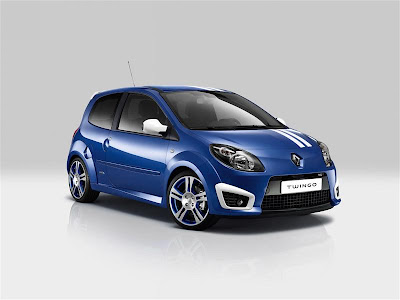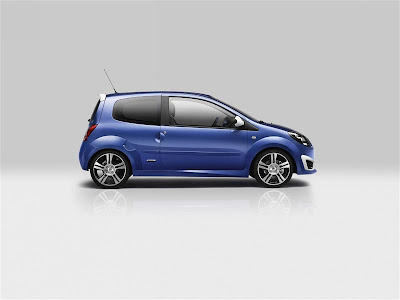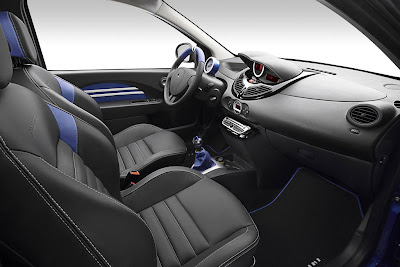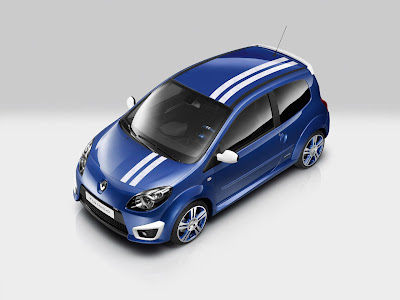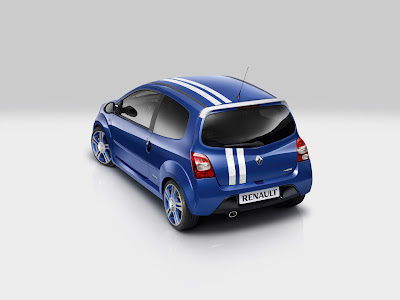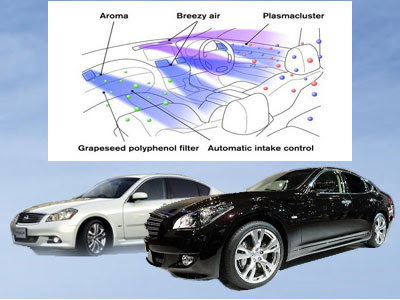India electric car pioneer plans biggest plug-in car plant
 Chetan Maini, the engineer who pioneered India’s first electric car, had his eureka moment two decades ago when he drove a vehicle fuelled by solar power across the blazing Australian outback.
Chetan Maini, the engineer who pioneered India’s first electric car, had his eureka moment two decades ago when he drove a vehicle fuelled by solar power across the blazing Australian outback.Now Maini, the man behind Reva Electric Car Co., is building in southern India what he says will be the world’s biggest factory making battery-powered city commuter cars.
“It’s the first attempt at mass production of a green car,” said Maini, who studied hybrid electric technology at California’s Stanford University and developed the no-clutch, no-gears Reva as head of a 75-member engineering team.
“With growing climate change awareness, I think we’re at the tipping point for electric cars,” Maini told AFP in an interview.
The drive in 1990 which set Maini on his career track was a General Motors-sponsored solar-powered race in which his car finished third, beating many of the global car companies.
“Driving across the continent on the sun’s energy made me think how we could use alternative energy to power cars in the Indian context,” he said.
“When I saw how our cities were getting polluted, I realised employing clean, alternative energy could make a lot of sense — we needed to develop this kind of technology,” he said.
Maini has put some 3,000 of the zero-polluting three-door Revas on the roads in India and Britain — where it is known as the G-Wiz — in the eight years since the company started selling the cars.
Reva was formed in 1994 as a joint venture between the family-owned Maini Group and AEV of the United States to manufacture environment-friendly vehicles.
But it took seven years for the first Reva to go on sale as Maini and his team worked on the design.
Afterward, “we were in a test marketing phase, trying to see how people used electric cars, what were their needs. But that’s now over and we’re ready to move to the mass-market stage,” Maini said.
In September, Reva got a big endorsement when GM announced it would team up with the tiny car company to develop a plug-in version of the best-selling GM Spark mini-car as the US giant embraces electrically powered driving.
“We think their technology is the best,” said GM India president Karl Slym.
The Reva — named after Maini’s mother — can seat two adults and two children and cover 50 miles (80 kilometres) on a single charge of electricity. New models feature sleeker looks than the Reva, which resembles a modified golf-cart, and will offer greater distance.
The company’s next generation three-door, four-seater hatchback NXR is intended to be a family car and will go into production in 2010. It will have a top speed of 65 miles per hour and travel 100 miles on a single charge.
The car will go on sale for around 10,000 euros (15,000 dollars) and can be charged in 90 minutes.
The higher-end NXG will have a 125-mile range and an 80 mile per hour top speed and sell for 23,000 euros in Europe.
The price of the new vehicles is not fixed for India but the cars are expected to sell for “much less,” said Maini.
The Reva currently retails for around 350,000 rupees (7,500 dollars) and is built at a small factory outside the southern city of Bangalore.
Maini is targeting people who want a vehicle for city jaunts or as a second automobile.
The cost of running an electric car in India is a tenth of a petrol-fuelled car, Maini said. The car has no oil filters, spark plugs or radiators so maintenance costs are also low.
“Since we started, there’s been quite a big change in consumer mind-sets,” said Maini, whose love affair with cars began when he was a child assembling remote-controlled toy vehicles.
“We are also seeing a large policy shift by governments to environmentally friendly vehicles,” he added.
Maini is eyeing annual sales of “5,000 plus” for the next three years and then 30,000 annually from cars produced at his new Bangalore factory, which is being built with venture funding.
There is a large market as the infrastructure for electricity is widespread — even in India, he said.
“All you need is the installation of a standard plug point — 15 amps — that is used for an air conditioner or an iron. Most people only need a larger car if they are going out of town.”
The tie-up with GM is part of a three-pronged strategy for Reva which wants to make its own cars under the Reva brand, franchise production in countries such as the United States and license the company’s technology for use by global companies.
GM and Reva have promised the new electrically powered Spark mini-car will be on Indian roads in a year and they see a market later abroad.
Cambodia: ‘Telepathic’ Car Symbolises Auto Industry
 The gold-coloured convertible turns heads on impoverished Cambodia’s roads — not least because of creator Nhean Phaloek’s outlandish claim that it can be operated telepathically.
The gold-coloured convertible turns heads on impoverished Cambodia’s roads — not least because of creator Nhean Phaloek’s outlandish claim that it can be operated telepathically.“I just snap my fingers and the car’s door will open. Or I just think of opening the car’s door, and the door opens immediately,” says the 51-year-old as he proudly shows off the homemade car, named the Angkor 333-2010.
Onlookers gasp as he demonstrates the trick, and with the fibre-glass vehicle having cost him $5,000 and 19 months of labour he is in no mood to reveal the remote control system behind it.
But as with a handful of other Cambodians who make their own curious cars, he dreams the two-seater will help foster an automobile industry in the country, still poor after decades of conflict.
“I am very excited and proud of this car because many people admire me and keep asking me about how I can make it,” he says, adding that it reaches speeds of up to 100 kilometres (62 miles) per hour. Kong Pharith, a 48-year-old former maths and physics teacher who has also produced his own car, says an auto industry is about to blossom in Cambodia.
“Our works will be part of a motivating force for the next generation to access new inventions and show the world that Cambodia has an ability to do what you think we cannot,” he says.
The inventor, who first came to national attention in 2005 for building a solar-powered bicycle, thinks he has now hit on a truly unique product with his orange, jeep-like vehicle with solar panels on its roof. Kong Pharith says it took him four months to design and put the final polish on his “tribrid” car which operates on solar energy, electricity and gasoline, hitting speeds of up to 40 kilometres per hour with its 2,000 watt motor.
“I’m really happy about my achievement but not very satisfied with it yet,” he says, adding that Cambodia’s lack of modern technology and materials are a minor obstacle to efficient manufacturing. The dream of building cars in Cambodia may not be far-fetched. Officials have announced plans for South Korean automaker Hyundai to open a plant in southwestern Cambodia, assembling some 3,000 vehicles per year.
Cambodia did actually assemble cars in a factory during the 1960s, before the country was caught in the maelstrom of the Vietnam War.
The Angkor 333-2010 is the third he has built, and his first to talk. When Phaloek slams the door a voice out of the dashboard moans: “Why do you close me too strongly?”
“Dozens of local and foreign guests have come and seen my car,” Nhean Phaloek says with a smile. “One British man told me that it is the Cambodian James Bond car.”
2010 9ff Speed9 Specification
2010 9ff Speed9 Technical Data and Specification
This is 9ff Speed9 bi-turbo engine generations 650 horsepower and delivers 890 nm torque at just 2850 rpm. This is achieved by the 9ff F650 VTG turbochargers, 100 cell sports catalytic converter as well as the 9ff stainless steel exhaust manifolds. Other measures like the 9ff sports air filter, the 9ff ECU upgrade and the 9ff sports exhaust system.
The demanding chassis, consisting of adjustable stabilizers on the front and rear axles, double springs, and four aluminum spring plates, support ambitious driving. One can also count on the 9ff brake system consisting of 380 mm compound brake discs in combination with 6-piston calipers and 9ff brake pads.
The 9ff Speed9 is available as a complete vehicle as well as a rebuilding order on the basis of a Porsche 997 Turbo.2010 9ff Speed9 Specifications![]()
Tuner 9ff
Engine Location Mid
Drive Type Rear Wheel
Engine
Engine Configuration O
Cylinders 6
Aspiration/Induction Twin-turbocharged
Displacement 3.60 L | 219.7 cu in. | 3600.9 cc.
Valves 24 valves.
4 valves per cylinder.
Valvetrain DOHC
Horsepower 650.00 BHP (478.4 KW)
Torque 890.00 NM (656.2 Ft-Lbs)
HP / Liter 180.6 BHP / Liter
Fuel Feed Fuel Injected
Block Aluminum
Head Aluminum
Standard Transmission
Gears 6
Transmission Semi-Automatic
Clutch Twin Clutch
Porsche PDK

2010 9ff Speed9 Specification
2010 9ff Speed9 Technical Data and Specification
This is 9ff Speed9 bi-turbo engine generations 650 horsepower and delivers 890 nm torque at just 2850 rpm. This is achieved by the 9ff F650 VTG turbochargers, 100 cell sports catalytic converter as well as the 9ff stainless steel exhaust manifolds. Other measures like the 9ff sports air filter, the 9ff ECU upgrade and the 9ff sports exhaust system.
The demanding chassis, consisting of adjustable stabilizers on the front and rear axles, double springs, and four aluminum spring plates, support ambitious driving. One can also count on the 9ff brake system consisting of 380 mm compound brake discs in combination with 6-piston calipers and 9ff brake pads.
The 9ff Speed9 is available as a complete vehicle as well as a rebuilding order on the basis of a Porsche 997 Turbo.2010 9ff Speed9 Specifications![]()
Tuner 9ff
Engine Location Mid
Drive Type Rear Wheel
Engine
Engine Configuration O
Cylinders 6
Aspiration/Induction Twin-turbocharged
Displacement 3.60 L | 219.7 cu in. | 3600.9 cc.
Valves 24 valves.
4 valves per cylinder.
Valvetrain DOHC
Horsepower 650.00 BHP (478.4 KW)
Torque 890.00 NM (656.2 Ft-Lbs)
HP / Liter 180.6 BHP / Liter
Fuel Feed Fuel Injected
Block Aluminum
Head Aluminum
Standard Transmission
Gears 6
Transmission Semi-Automatic
Clutch Twin Clutch
Porsche PDK

2010 Nissan Fuga Priced Sports Sedan The first vehicle to be equipped with the new system “Forest AC”
The interior of Fuga is garnished with a nice blend of leather and and wood grain panels coated with genuine silver powder, which gives them an immaculate mirror finish. It features a new “Forest AC” air conditioning system that creates the refreshing climate, fragrance and natural breezes of a relaxing forest setting.
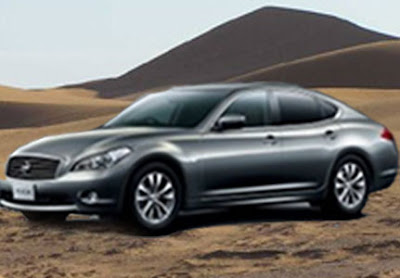
2010 Nissan Fuga Priced Sports Sedan
Nissan has revealed their latest innovation in air conditioning systems - and it's a good one. The "Forest AC" controls the aroma and humidity to help create an optimal interior environment for the occupants. The system uses a number of advanced technologies and is designed to recreate the refreshing climate, fragrance and natural breezes of relaxing forest settings. It was developed based on the results of a joint research study with the Tokyo University of Science on the effects of aroma on human mental activity.

2010 Nissan Fuga Priced Sports Sedan
Along with the air-cleaning and temperature control effect of conventional car air conditioners, the new Forest AC system offers additional control of air flow, humidity, aroma and other ambient factors that can influence the physiological state and senses of the driver and passengers. This is the first automotive system in the world created to make driving more comfortable based on studies of drivers' mental activity.The first vehicle to be equipped with the new system is the 2010 Nissan Fuga.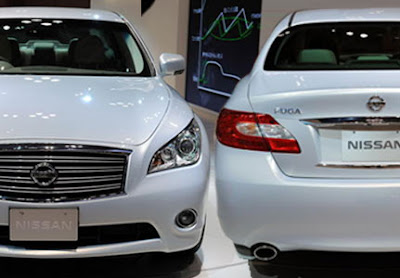

2010 Nissan Fuga Priced Sports Sedan
As we are approaching the new year, manufacturers are announcing new pricing on 2010 updated and new models. One of these new models which was unveiled at this year’s Tokyo Autoshow and received very good media is the Nissan Fuga, an Infiniti based luxury sedan which firstly will go on sale in Japanese domestic market. The car is very well equipped and comes with lots of new features starting at around $45,000.
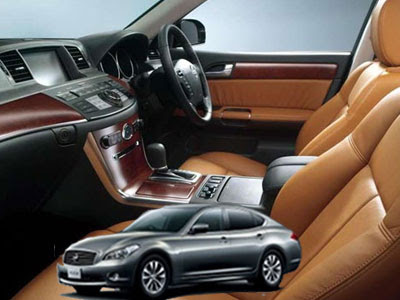
2010 Nissan Fuga Priced Sports Sedan
Since its debut in 2004, the Fuga has been highly praised by customers for its exceptional performance, class-leading interior roominess and a variety of luxurious interior trim options. The new Fuga takes each attribute to a new and higher level.
The new Fuga features a revised model lineup, a redesigned exterior and interior, Nissan’s new VQ35HR and VQ25HR engines and the world’s first*1 Distance Control Assist (Intelligent Pedal) System*2, among other refinements, the combination of which further advances the car’s all-around qualities as a premium sports sedan.

2010 Nissan Fuga Priced Sports Sedan
Living up to its marketing tagline of “SHIFT_luxury,” Fuga transforms the traditional notion of a luxury car. Fuga is available in three grades (GT, GT Type S and GT Type P) for three engine variations (V6 2.5-liter, V6 3.6-liter and V8 4.5-liter). 4WD version is available for 350GT.
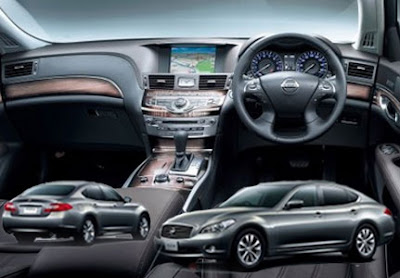
2010 Nissan Fuga Priced Sports Sedan
The new Fuga announces its substantial presence and premium class image with a new “look” featuring redesigned headlights, grille, front and rear bumpers and rear combination lamps. Making even more of a statement is the GT Type S model, with an exterior styling package that includes new side sill spoilers and a “smoky chrome” finish to the inside of the headlights.
2010 Nissan Fuga Priced Sports Sedan The first vehicle to be equipped with the new system “Forest AC”
The interior of Fuga is garnished with a nice blend of leather and and wood grain panels coated with genuine silver powder, which gives them an immaculate mirror finish. It features a new “Forest AC” air conditioning system that creates the refreshing climate, fragrance and natural breezes of a relaxing forest setting.

2010 Nissan Fuga Priced Sports Sedan
Nissan has revealed their latest innovation in air conditioning systems - and it's a good one. The "Forest AC" controls the aroma and humidity to help create an optimal interior environment for the occupants. The system uses a number of advanced technologies and is designed to recreate the refreshing climate, fragrance and natural breezes of relaxing forest settings. It was developed based on the results of a joint research study with the Tokyo University of Science on the effects of aroma on human mental activity.

2010 Nissan Fuga Priced Sports Sedan
Along with the air-cleaning and temperature control effect of conventional car air conditioners, the new Forest AC system offers additional control of air flow, humidity, aroma and other ambient factors that can influence the physiological state and senses of the driver and passengers. This is the first automotive system in the world created to make driving more comfortable based on studies of drivers' mental activity.The first vehicle to be equipped with the new system is the 2010 Nissan Fuga.

2010 Nissan Fuga Priced Sports Sedan
As we are approaching the new year, manufacturers are announcing new pricing on 2010 updated and new models. One of these new models which was unveiled at this year’s Tokyo Autoshow and received very good media is the Nissan Fuga, an Infiniti based luxury sedan which firstly will go on sale in Japanese domestic market. The car is very well equipped and comes with lots of new features starting at around $45,000.

2010 Nissan Fuga Priced Sports Sedan
Since its debut in 2004, the Fuga has been highly praised by customers for its exceptional performance, class-leading interior roominess and a variety of luxurious interior trim options. The new Fuga takes each attribute to a new and higher level.
The new Fuga features a revised model lineup, a redesigned exterior and interior, Nissan’s new VQ35HR and VQ25HR engines and the world’s first*1 Distance Control Assist (Intelligent Pedal) System*2, among other refinements, the combination of which further advances the car’s all-around qualities as a premium sports sedan.

2010 Nissan Fuga Priced Sports Sedan
Living up to its marketing tagline of “SHIFT_luxury,” Fuga transforms the traditional notion of a luxury car. Fuga is available in three grades (GT, GT Type S and GT Type P) for three engine variations (V6 2.5-liter, V6 3.6-liter and V8 4.5-liter). 4WD version is available for 350GT.

2010 Nissan Fuga Priced Sports Sedan
The new Fuga announces its substantial presence and premium class image with a new “look” featuring redesigned headlights, grille, front and rear bumpers and rear combination lamps. Making even more of a statement is the GT Type S model, with an exterior styling package that includes new side sill spoilers and a “smoky chrome” finish to the inside of the headlights.
Sebelum 2016 Indonesia Harus Memproduksi Automotif
 Bila sampai 2016 Indonesia terus-menerus mendatangkan mobil hasil produksi prinsipal, maka diyakini negara ini akan selalu menajdi negara pengimpor, bukan pengekspor.
Bila sampai 2016 Indonesia terus-menerus mendatangkan mobil hasil produksi prinsipal, maka diyakini negara ini akan selalu menajdi negara pengimpor, bukan pengekspor.Demikian ditegaskan Presiden Direktur PT Toyota Astra Motor (TAM) Johnny Darmawan ketika ditemui di Jakarta belum lama ini.
Dia menuturkan, Indonesia harus bisa menjadi negara basisi produksi kendaraan bermotor bukan hanya sebagai importir. "Kalau sampai 2016 kita terus menerus impor, kita tidak akan pernah bisa ekspor," katanya yang juga bertindak sebagai Wakil Ketua Gabungan Industri Kendaraan Bermotor Indonesia (Gaikindo).
Untuk itulah ia mengharapkan situasi politik dan ekonomo dlama negeri terus membaik sehingga menumbuhkan kepercayaan para investor asing guna menanamkan modalnya di negara ini.
"Kita buat bagaimana para investor asing itu tertarik bangun pabrik kendaraan bermotor di Indonesia, supaya kita bisa produksi sendiri," ujarnya.
Setelah para investor itu masuk, maka Indonesia akan bisa menjadi basis produksi kendaraan bermotor bagi negara-negara lain. "Kalau sudah seperti itu kan tinggal tentukan negara tujuan ekspor, jadi jangan terus menerus jadi importir," tegas Johnny.
2011 McLaren MP4-12C Super Sports Concept Car pure McLaren, Powered by a twin-turbocharged 3.8 litre, V8 Engine

2011 McLaren MP4-12C
The independent car division based at the McLaren Technology Centre in Woking, England,the McLaren MP4-12C is revealed as the first in a range of high-performance sports cars from McLaren Automotive.The 12C, and future models within the range, will challenge the world's best sports cars, benefiting from the expertise and virtuosity of the McLaren Group.
Through a rich modern history, McLaren's automotive division has already built the world's most critically acclaimed supercar, the McLaren F1 (1993-1998) and the world's best-selling luxury supercar, the Mercedes-Benz SLR McLaren (2003-2009). McLaren Automotive now looks to the future with a new range of revolutionary sports cars.
At its heart, the McLaren MP4-12C features a revolutionary carbon fibre chassis structure, the Carbon MonoCell: the first time a car in this market segment is based around such a strong and lightweight racing car engineering solution and the first time any car has ever featured a one-piece carbon fibre structure.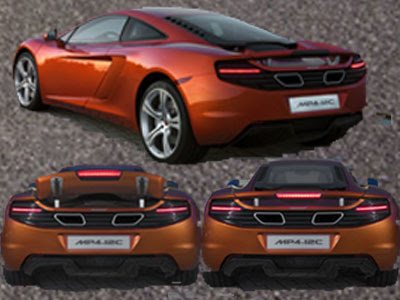

2011 McLaren MP4-12C
Martin Whitmarsh : "McLaren has for years offered a potent mix of race car and road car technologies. This combination of McLaren's performance heritage, and future demands on what is expected of high performance sports cars in the 21st century, gave us a head-start when we embarked on this project. The 12C, and future variants, draws on the spirit of Formula 1 and delivers real-world technological advances."
The first car from the new company, the McLaren MP4-12C, is a high performance two-seat mid-engine model in the 'core' sports car market segment for cars costing between £125,000 and £175,000.It goes on sale through a dedicated, worldwide retailer network in early 2011.
All the parts of the McLaren MP4-12C are bespoke and unique to this car. Everything from the engine right down to the tailor-made switches and buttons is pure McLaren: nothing has come from another manufacturer's parts bin.
The first car from the new company, the McLaren MP4-12C, is a high performance two-seat mid-engine model in the 'core' sports car market segment for cars costing between £125,000 and £175,000.It goes on sale through a dedicated, worldwide retailer network in early 2011.
All the parts of the McLaren MP4-12C are bespoke and unique to this car. Everything from the engine right down to the tailor-made switches and buttons is pure McLaren: nothing has come from another manufacturer's parts bin.
The 12C is powered by a bespoke McLaren 'M838T' 3.8 litre, V8 twin-turbo engine producing around 600bhp, driving through a McLaren seven speed Seamless Shift dual clutch gearbox (SSG). It is targeting not only new standards for power and performance in its sector, but also class-leading fuel economy and CO2 emissions; supported by McLaren's experience of active aerodynamics to aid cooling, grip, handling and road holding.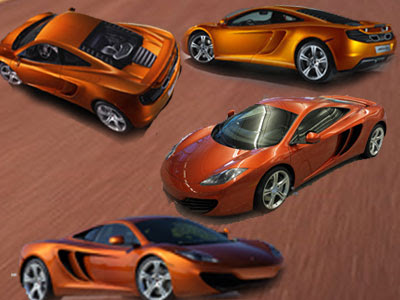

2011 McLaren MP4-12C
"The 12C is all about performance," said Sheriff. "And in McLaren, we have a very broad definition of performance. We don't just look at the traditional one-dimensional parameters like top speed, we focus equally on useable measures such as in-gear acceleration times, braking performance in all conditions, and efficiency of power delivery combined with the lowest possible fuel consumption and CO2 emissions. Sure, 12C is very fast, but it is also the most efficient, most driveable high-performance sports car in the world.
Thorough engineering and market research led to concept development and a clear decision in favour of a mid-engined two door high performance sports car. Intensive work was carried out in the wind tunnel and the driving simulator to ensure that the new car would inherently have superb dynamic qualities.
The McLaren MP4-12C design follows similar principles to McLaren's Formula 1 cars, and the legendary McLaren F1, where everything is for a reason and all lines, surfaces, and details are designed with a job in mind as much as styled. This ensures that the 12C communicates its engineering through its styling and will remain timeless as a piece of automotive design.
"By the time the 12C is launched in 2011 we expect the economic conditions to be much improved. We have already seen significant interest in the car and the supply of the 12C will be relatively scarce; in its first year we plan to produce just 1,000 cars which represents only 3.5 per cent of the 'core' market," explained Antony Sheriff.

2011 McLaren MP4-12C
The McLaren MP4-12C is powered by a twin-turbocharged, 3.8 litre 90° V8 engine - the 'M838T'. This marks the start of a new era in 'core' segment sports cars - smaller capacity, lighter weight, higher efficiency and more economical power units. The engine has the highest specific power output in its segment which, when allied to its low weight carbon composite chassis, delivers exemplary power- and torque-to-weight ratios.The McLaren engine revs to 8,500rpm, has quick transient throttle response and delivers its abundant torque throughout the rev range. A staggering 80 per cent of torque is available at below 2,000rpm, ensuring great driveability and no need to floor the throttle to deliver performance.
The McLaren MP4-12C has been designed around a demanding mechanical package that puts emphasis on aerodynamics, compact dimensions, performance and efficiency, practicality and comfort. Although the design of the 12C was driven by aerodynamics, it aims to remain contemporary and elegant throughout its lifetime as well as distinctive among its peers.
"The 12C design was therefore led by aerodynamics. At McLaren we have been able to use the Formula 1 techniques and the huge expertise that the company has amassed at the pinnacle of the sport," explained Stephenson.
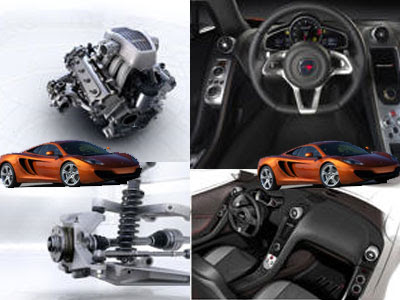
2011 McLaren MP4-12C
Aerodynamic efficiency drove the 12C's design. High downforce helps maintain traction, cornering ability and stability while low drag aids top speed and acceleration. It has a completely flat underbody and smooth upper body surfaces to yield a highly effective drag coefficient and generate very high levels of balanced downforce at high speed.
2011 McLaren MP4-12C Super Sports Concept Car pure McLaren, Powered by a twin-turbocharged 3.8 litre, V8 Engine

2011 McLaren MP4-12C
The independent car division based at the McLaren Technology Centre in Woking, England,the McLaren MP4-12C is revealed as the first in a range of high-performance sports cars from McLaren Automotive.The 12C, and future models within the range, will challenge the world's best sports cars, benefiting from the expertise and virtuosity of the McLaren Group.
Through a rich modern history, McLaren's automotive division has already built the world's most critically acclaimed supercar, the McLaren F1 (1993-1998) and the world's best-selling luxury supercar, the Mercedes-Benz SLR McLaren (2003-2009). McLaren Automotive now looks to the future with a new range of revolutionary sports cars.
At its heart, the McLaren MP4-12C features a revolutionary carbon fibre chassis structure, the Carbon MonoCell: the first time a car in this market segment is based around such a strong and lightweight racing car engineering solution and the first time any car has ever featured a one-piece carbon fibre structure.

2011 McLaren MP4-12C
Martin Whitmarsh : "McLaren has for years offered a potent mix of race car and road car technologies. This combination of McLaren's performance heritage, and future demands on what is expected of high performance sports cars in the 21st century, gave us a head-start when we embarked on this project. The 12C, and future variants, draws on the spirit of Formula 1 and delivers real-world technological advances."
The first car from the new company, the McLaren MP4-12C, is a high performance two-seat mid-engine model in the 'core' sports car market segment for cars costing between £125,000 and £175,000.It goes on sale through a dedicated, worldwide retailer network in early 2011.
All the parts of the McLaren MP4-12C are bespoke and unique to this car. Everything from the engine right down to the tailor-made switches and buttons is pure McLaren: nothing has come from another manufacturer's parts bin.
The first car from the new company, the McLaren MP4-12C, is a high performance two-seat mid-engine model in the 'core' sports car market segment for cars costing between £125,000 and £175,000.It goes on sale through a dedicated, worldwide retailer network in early 2011.
All the parts of the McLaren MP4-12C are bespoke and unique to this car. Everything from the engine right down to the tailor-made switches and buttons is pure McLaren: nothing has come from another manufacturer's parts bin.
The 12C is powered by a bespoke McLaren 'M838T' 3.8 litre, V8 twin-turbo engine producing around 600bhp, driving through a McLaren seven speed Seamless Shift dual clutch gearbox (SSG). It is targeting not only new standards for power and performance in its sector, but also class-leading fuel economy and CO2 emissions; supported by McLaren's experience of active aerodynamics to aid cooling, grip, handling and road holding.

2011 McLaren MP4-12C
"The 12C is all about performance," said Sheriff. "And in McLaren, we have a very broad definition of performance. We don't just look at the traditional one-dimensional parameters like top speed, we focus equally on useable measures such as in-gear acceleration times, braking performance in all conditions, and efficiency of power delivery combined with the lowest possible fuel consumption and CO2 emissions. Sure, 12C is very fast, but it is also the most efficient, most driveable high-performance sports car in the world.
Thorough engineering and market research led to concept development and a clear decision in favour of a mid-engined two door high performance sports car. Intensive work was carried out in the wind tunnel and the driving simulator to ensure that the new car would inherently have superb dynamic qualities.
The McLaren MP4-12C design follows similar principles to McLaren's Formula 1 cars, and the legendary McLaren F1, where everything is for a reason and all lines, surfaces, and details are designed with a job in mind as much as styled. This ensures that the 12C communicates its engineering through its styling and will remain timeless as a piece of automotive design.
"By the time the 12C is launched in 2011 we expect the economic conditions to be much improved. We have already seen significant interest in the car and the supply of the 12C will be relatively scarce; in its first year we plan to produce just 1,000 cars which represents only 3.5 per cent of the 'core' market," explained Antony Sheriff.

2011 McLaren MP4-12C
The McLaren MP4-12C is powered by a twin-turbocharged, 3.8 litre 90 V8 engine - the 'M838T'. This marks the start of a new era in 'core' segment sports cars - smaller capacity, lighter weight, higher efficiency and more economical power units. The engine has the highest specific power output in its segment which, when allied to its low weight carbon composite chassis, delivers exemplary power- and torque-to-weight ratios.The McLaren engine revs to 8,500rpm, has quick transient throttle response and delivers its abundant torque throughout the rev range. A staggering 80 per cent of torque is available at below 2,000rpm, ensuring great driveability and no need to floor the throttle to deliver performance.
The McLaren MP4-12C has been designed around a demanding mechanical package that puts emphasis on aerodynamics, compact dimensions, performance and efficiency, practicality and comfort. Although the design of the 12C was driven by aerodynamics, it aims to remain contemporary and elegant throughout its lifetime as well as distinctive among its peers.
"The 12C design was therefore led by aerodynamics. At McLaren we have been able to use the Formula 1 techniques and the huge expertise that the company has amassed at the pinnacle of the sport," explained Stephenson.

2011 McLaren MP4-12C
Aerodynamic efficiency drove the 12C's design. High downforce helps maintain traction, cornering ability and stability while low drag aids top speed and acceleration. It has a completely flat underbody and smooth upper body surfaces to yield a highly effective drag coefficient and generate very high levels of balanced downforce at high speed.
Subscribe to:
Comments (Atom)



